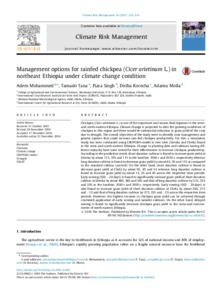Management options for rainfed chickpea ( Cicer arietinum L.) in northeast Ethiopia under climate change condition
Abstract
Chickpea (Cicer arietinum L.) is one of the important cool season food legumes in the semi-arid north-eastern Ethiopia. Climate change is projected to alter the growing conditions of chickpea in this region and there would be substantial reduction in grain yield of the crop due to drought. The overall objectives of the study were to identify crop management and genetic options that could increase rain-fed chickpea productivity. For this, a simulation study has been conducted using CROPGRO-model in two sites (Sirinka and Chefa) found in the semi-arid north-eastern Ethiopia. Change in planting date and cultivars having different maturity have been tested for their effectiveness to increase chickpea productivity. According to the prediction result, short duration cultivar is found to increase grain yield at Sirinka by about 11%, 10% and 11% in the baseline, 2030 s and 2050 s, respectively whereas long duration cultivar is found to decrease grain yield by about 6%, 9% and 11% as compared to the standard cultivar (control). On the other hand, short duration cultivar is found to decrease grain yield at Chefa by about 9%, 4% and 5% whereas long duration cultivar is found to increase grain yield by about 1%, 2% and 4% across the respective time periods. Early sowing (SSD − 20 days) is found to significantly increase grain yield of short duration cultivar at Sirinka by about 48%, 48% and 54% and that of long duration cultivar by 31%, 33% and 39% in the baseline, 2030 s and 2050 s, respectively. Early sowing (SSD − 20 days) is also found to increase grain yield of short duration cultivar at Chefa by about 26%, 27% and −1% and that of long duration cultivar by 37%, 32% and −2% across the respective time periods. However, the highest increase in chickpea grain yield can be achieved through combined application of early sowing and suitable cultivars. On the other hand, delayed sowing is found to significantly decrease chickpea grain yield in the semi-arid environments of north-eastern Ethiopia

